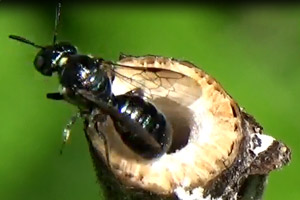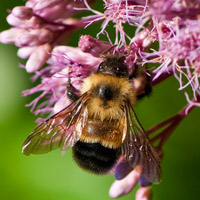About MN Bee Atlas
What is the Minnesota Bee Atlas?

Copyright © Colleen Satyshur
When most people hear the word “bee” they probably picture a yellow and black striped honey bee or a big, fluffy bumble bee. Honey bees and bumble bees are easily recognized and play an important role in pollination, but they are a small fraction of the almost 20,000 bee species in the world. In contrast to honey bees and bumble bees, most bees are solitary and build their nests alone. They may live near other bees of the same species, but they do not work together to form one colony. The current Minnesota bee list includes 455 species and counting!
The first phase of the Minnesota Bee Atlas, a four-year project funded by the Minnesota Environment and Natural Resources Trust Fund (ENRTF), was a citizen science program designed to use volunteer participants to learn about the distributions of native bees in Minnesota. The observations of public participants combined with historical records from the University of Minnesota Insect collection added 5 new bee species to the state species list, documented new locations for endangered and rare bumble bees, and expanded our knowledge of bee distributions, phenology, and habitat associations.The information we gathered on species distribution and diversity will be important to help us track if or how bee populations are changing and how those changes might affect land management decisions.
Nesting blocks
The second phase of the MN Bee Atlas will focus on the plants that tunnel-nesting bees use to build their nests, while continuing to learn about distributions, phenology, and habitat associations. Many tunnel-nesting bees use leaf pieces, chewed leaves, plant resins, or plant hairs to line and cap the nests where their offspring will develop and over-winter. The Bee Atlas will use DNA and resin analysis to identify which plants the bees are using so that we can understand this important part of their habitat needs.
We will distribute nesting blocks to volunteers in spring 2022, to be placed in areas such as county parks, nature centers, and
DNR
Scientific and Natural Areas (SNAs) across the state. Bees will nest in these blocks, and volunteers will observe the blocks to see when bees are most active and what they build their nests out of. When blocks are returned to our lab in the fall, Bee Atlas staff will take samples of nesting material for analysis and rear larvae from the nests to adulthood for identification.
You can also help us learn about the plants that bees are using by taking pictures of the cuts that leaf-cutter bees make in plant leaves and uploading them to the Megachile Bee Leaf Cuts iNaturalist project. To submit observations, you will first need to create an account on iNaturalist. After you have created an account, click on “Projects” at the top of the page and search for “Megachile Bee Leaf Cuts” to submit your observations.
Contact MN Bee Atlas for more information about volunteering.
Using your own nesting blocks
If you are interested in putting up a bee block in your yard to observe and host tunnel-nesting bees, there are many companies offering pre-made bee houses as well as directions to build your own. We like the suggestions offered by Joel Gardner, in his paper “Native Bees, Solitary Bees, and Wild Bees: What are they?” and the Xerces Society website, “Providing nest sites for pollinators”.
Although we are limited in the number of larvae we can rear and cannot accept additional blocks, we welcome observations of your backyard bee nests. If you see bees using your bee house you can submit pictures to the MN Bee Atlas iNaturalist project the same way you would for “Anecdotal observations”.
Bumble bees

Copyright © Heather Holm
Bumble bee surveys continue with the Minnesota Bumble Bee Atlas, a joint project with the Xerces Society for Invertebrate Conservation. Volunteers will catch and release bumble bees in surveys throughout the state. Learn more at mnbumblebeeatlas.umn.edu.
Photographs of bumble bees you see while camping, hiking, walking the dog, etc. can be submitted to the Xerces Society’s Bumble Bee Watch project. See recommendations in “Anecdotal observations” regarding bee photography. MN records from Bumble Bee Watch will be integrated into the Minnesota Bee Atlas.
Anecdotal observations
Although you may not notice each one, chances are that you cross paths with several different bee species on a regular basis. Some may be smaller than you expect and many look quite different than the honey or bumble bees that most of us are used to. Colors can range from metallic greens and blues to combinations of yellow, white, black, and red, but most bees are covered in hairs that make them look “fuzzy”. If you see an insect with pollen stuck in the hairs on her legs or abdomen, you are looking at a bee!
To submit observations of bees you see when you are out and about, you will first need to create an account on iNaturalist. After you have created an account, click on “Projects” at the top of the page and search for “Minnesota Bee Atlas” to submit your observations. Do not worry if you do not know the species of bee, just fill in as much information as you can. Other volunteers may be able to identify the bee based on your photo.
For the greatest chance of using your photo to identify the bee species, please submit clear photos that are in color. Photographing the bee from different angles often helps reviewers. You may also want to boost the number of bees you may find in your yard by providing nectar and nesting habitat.